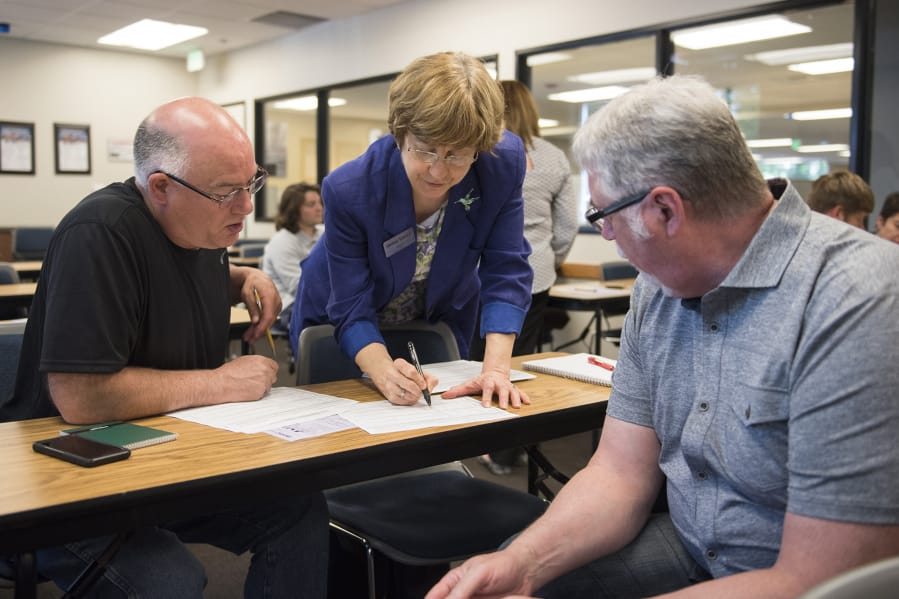The cavernous Georgia-Pacific paper mill, which churned with thousands of papermakers a generation ago, is now a ghost town, said Felicia Tillery; and former workers like her are in limbo.
“It is hard,” she said, trying to describe this past month when up to 300 workers have been laid off. Her last day was June 1, though she is luckier than most because her children are grown and she can get by on her husband’s income and benefits.
“I might retire. I might do something else. It just depends on what comes up,” she said. “I’m not devastated … (but) there’s a lot of people that work really hard that I think are devastated.”
Tillery made her comments from a classroom at WorkSource Vancouver, where she recently joined a handful of ex-mill workers looking for help with life after layoffs.
There, at 204 S.E. Stone Mill Drive, representatives from WorkSource try to help laid off former mill workers carve out some options, like applying for new jobs, filing for unemployment benefits or even enrolling in school.
In November, Georgia-Pacific announced it would lay off the majority of its remaining workforce in Camas. The Atlanta, Ga.-based company, a wholly owned subsidiary of Koch Industries, said demand has dwindled for communications paper, used in office copiers, printers and the like.
Large portions of the mill will be torn down starting next year and layoffs began this spring. The mill, which arrived in the late 19th century and peaked at 2,600 jobs in the 1970s, will be left with just over 100 workers to keep running a machine that makes tissue products such as paper towels.
Ex-employees are arriving in waves at WorkSource, as layoffs often fall near the end of the week. Many are resigned to the idea they won’t find jobs that pay as well. Many are older, too, and worry employers won’t look twice at someone nearing retirement.
“I have good days when I’m pretty confident,” said Norm Lackey, a former hazardous waste worker at the mill. He was laid off after more than two decades there. “And there are times when I can’t sleep at night.”
Tough choices
Randy Etheridge, who followed his father into a three-decade career in preventative maintenance at the mill, is facing a tough choice.
At 54 years old, he has no plans to work at another pulp and paper mill. He would start at the bottom rung of wages and seniority. The prospect of layoffs would loom in the back of his mind.
“You never thought after 30 years you’d have to find another job,” he said. But, on the other hand, finding work elsewhere seems like a risk at his age. “Do they want to hire an age 50-plus guy?”
This is the quandary facing many of the former mill workers who are not certified tradespeople, such as electricians. Those jobs are in demand and many are able to find work elsewhere.
If general workers can’t ride their severance package to retirement, they will likely find jobs that pay less or offer thinner benefits packages. The average hourly worker made $27 per hour at the mill, according to Georgia-Pacific.
Greg Pallesen, president of the Association of Western Pulp and Paper Workers union, said not even the most skilled workers are finding jobs as good as they had in Camas.
“I know of no one who has gone to work or has a job lined up where they are going to make equivalent wages, benefits, vacation time — all of that,” he said. “Some of them will get jobs, but most likely it’s not going to pay the same.”
Hit the books
Going back to school could be an option. The U.S. Department of Labor is considering offering Trade Adjustment Assistance to former mill workers, which would help pay for college. But that has not yet been approved.
Lackey, 62, hopes to take classes at Clark College to pursue a career in emergency management. At Georgia-Pacific he spent his time as an industrial firefighter and a chemical recovery operator.
“Some guys say there is life after the mill, but it’s kind of divided,” he said. “Some did worse, some did better.”
There appear to be many departing workers who feel as uncertain. According to Darcy Hoffman, who helps lead WorkSource’s efforts to connect workers with new jobs, there are many companies interested in hiring former mill workers, but few of those who are losing their jobs are taking advantage of the opportunity.
Perhaps it is the low unemployment rate, or the age of the workers. Hoffman said that could be because layoffs are still ongoing.
“At this point it has been a little quieter but they’re still going through the layoff procedure,” she said. “I’m still hopeful we’ll be able to connect with people. We definitely need more. But, anecdotally, I think we’re a little bit early.”
Others say these latest layoffs are falling on a senior group of workers. Many had racked up years of service, with union representatives estimating the average worker to be in his or her late 40s and early 50s. Some are close enough to retirement they won’t look for work, while others may just be taking time to regroup.
“I had a retirement plan and it was working! I was going to retire at 62,” said Ellisa Schiffman, a buyer who was laid off after nearly two decades.
Schiffman herself, alongside Denise Korhonen, is now a peer coordinator with WorkSource to help former co-workers navigate unemployment. She said she’s heard from people who just plan to lay low for now.
“I think some of there are taking time to decompress,” she said. “A couple people say ‘I’m just going to go to the beach and relax.’ ”
Korhonen and Schiffman will work full time to get help for their former peers at the mill. They are optimistic and have heard some success stories of people going to work for BNSF Railway, Daimler Trucks North America or Nippon Paper in Longview.
“But I haven’t seen anybody happy,” Korhonen said.




